The finger monkey is also known as the pygmy marmoset. These are the smallest species of monkeys in the world. They are tiny, weighing only about 3.5 to 4.5 ounces and growing between 4.6 and 6.2 inches long, not including their tails. These monkeys live in the rainforests of South America, often in the treetops, where they use their sharp claws to climb trees and branches.
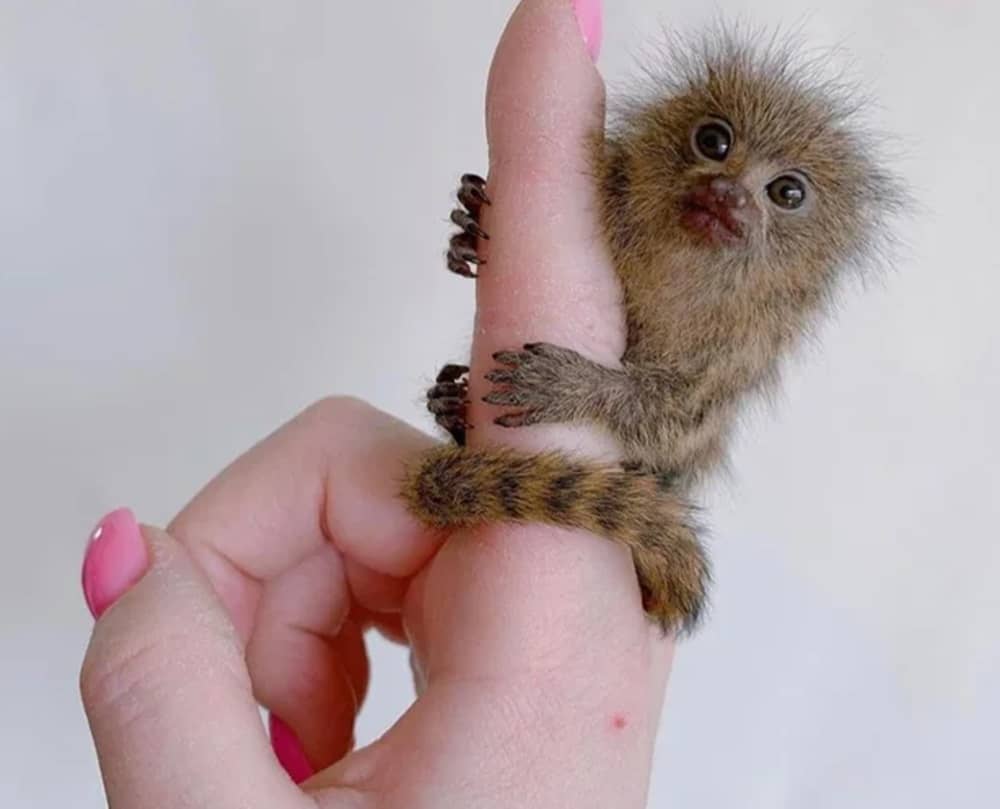
Finger monkeys are highly adaptable and can grip tree bark tightly. They use their claws not only for climbing but also for digging into tree trunks to find sap. They enjoy eating fruits, insects, and small animals like butterflies. Their small size makes it easy for them to move around quickly and hide from predators.
These monkeys are also social creatures that groom each other’s fur as a way to bond, much like other primates. Finger monkeys usually live in small family groups, often with one male and one female pair that mate and stay together for life. They are known to be protective of their young ones and their territory.
Even though finger monkeys are adorable and small, they have specific needs, especially when kept as pets. These require a suitable enclosure that mimics their natural environment, with plenty of branches for climbing and a balanced diet to stay healthy. They are also very active animals, so they need regular mental and physical stimulation to prevent boredom and behavioral issues.
Size & Lifespan of a Finger Monkey
Finger monkeys, also known as pygmy marmoset. They typically grow to about 4 to 6 inches (10 to 15 cm) in body length, not including its tail. Their tails are longer than their bodies, reaching up to 9 inches. Adult finger monkeys usually weigh around 3.5 to 5 ounces (100 to 140 grams). Finger monkeys usually live for 12 to 15 years in captivity when given proper care. In the wild, their lifespan may be shorter due to predators and other challenges. providing a healthy environment, good nutrition, and regular veterinary care can help them live a long, happy life.
Behavior And Temperament
Finger monkeys are active, curious, and social creatures. In the wild, they live in small family groups and form close bonds with one another. They are very playful and spend a lot of time climbing trees, jumping from branch to branch, and exploring their environment. finger monkeys use their sharp claws to grip onto branches, which helps them move around quickly and find food.
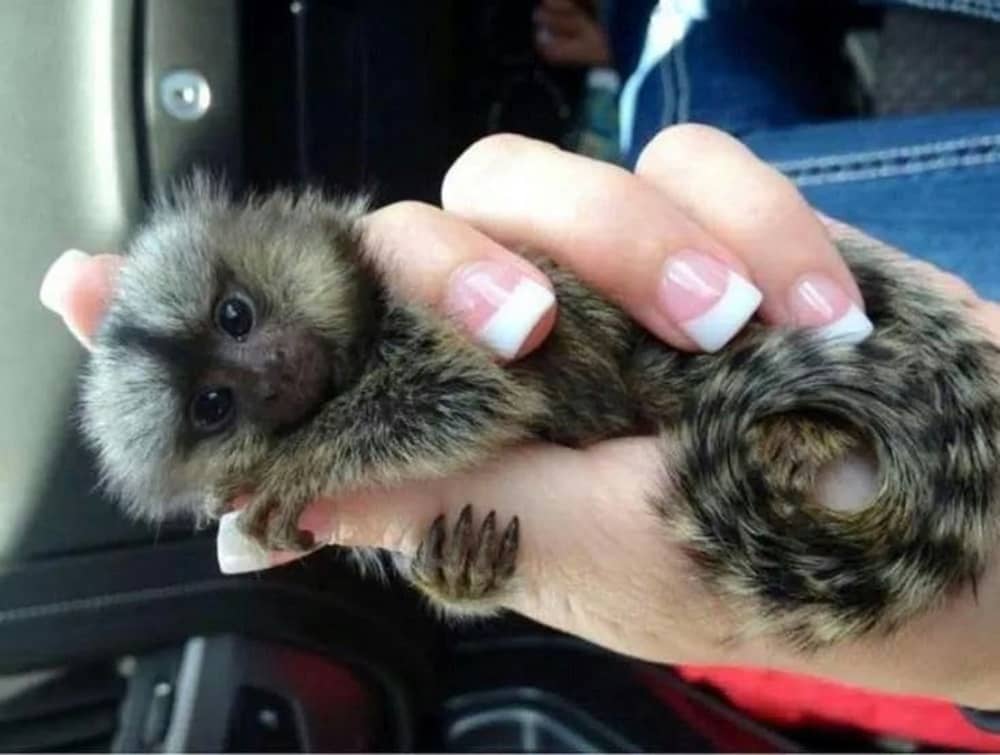
These tiny monkeys communicate using various sounds like whistles, chirps, and trills, and they rely on these calls to stay in touch with their group members. They also groom each other as a way to strengthen social bonds, showing their friendly and caring nature. When they feel threatened or sense danger, they feel threatened or sense danger, they may become defensive, showing protective behavior to guard their family.
As pets, finger monkeys can be affectionate but also demanding. They need lots of attention, playtime, and interaction to stay happy and healthy. If they feel neglected or bored, they might develop aggressive or destructive behaviors. it’s important for their owners to create an environment that mimics their natural habitat and provide activities that keep them mentally and physically stimulated. Overall, while they are playful and loving, finger monkeys require consistent care and attention to maintain their social and energetic nature.
How to Take Care of Finger Monkeys?
To care for a finger monkey, create a safe and comfortable habitat. Make sure the enclosure is spacious and has lots of branches and toys for climbing and playing, as finger monkeys are very active and love to explore.
Diet is important; feed them a mix of fruits, vegetables, insects, and social monkey food to keep them healthy. Fresh water should always be available. Direct sunlight is preferred, but a heat lamp or other artificial light source can be attached to the cage if natural light isn’t regularly available.
Handle them gently and slowly so they can get used to you and build trust. Spend time playing and bonding with them daily to keep them happy and social.
Regular vet check-ups are necessary to monitor their health and prevent issues. Maintaining a clean environment and grooming them occasionally will also help them stay healthy.
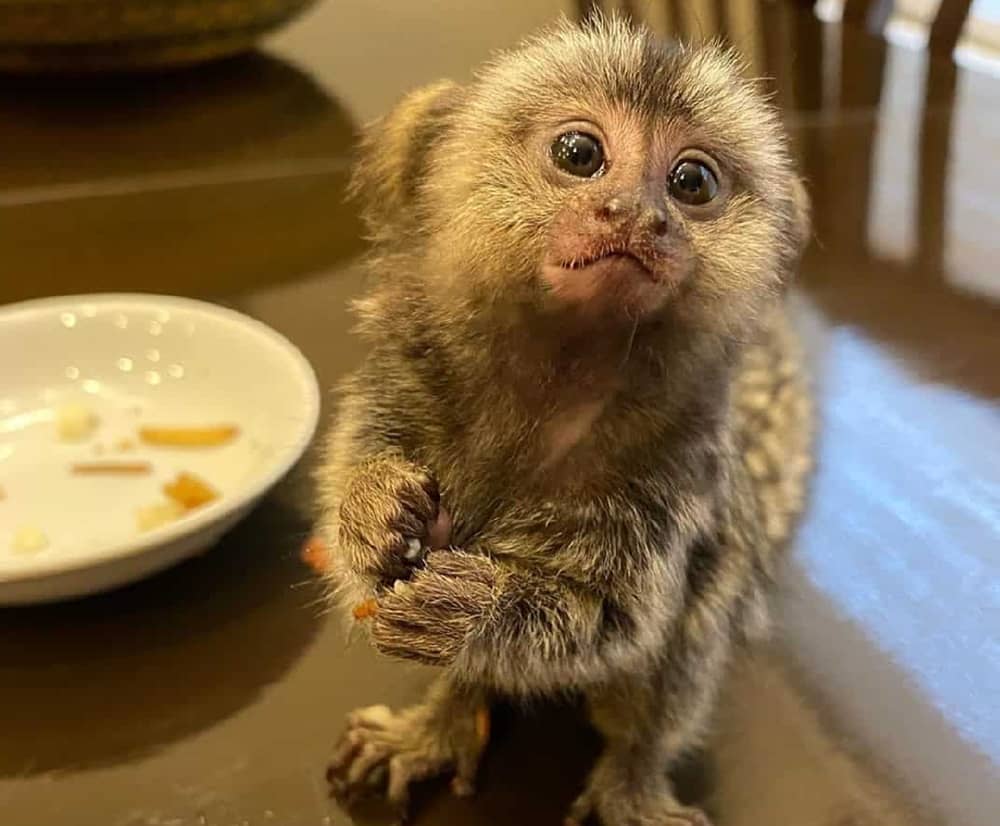
Enclosure of a Finger Monkey
To set up an enclosure for a finger monkey, ensure it’s spacious and secure. The cage should be tall, with plenty of branches and ropes for climbing, as these monkeys love to explore and jump around. Include toys and enrichment items like swings and puzzle feeders to keep them mentally stimulated.

The enclosure should have multiple levels and hiding spots so the monkey can feel safe and comfortable. Ensure the temperature inside the cage is warm and consistent, around 75-85°F (24-29°C), since finger monkeys are sensitive to cold.
Keep the area clean by regularly changing bedding and wiping down surfaces to prevent illness. Make sure there’s a steady supply of fresh water and provide a variety of food options like fruits, vegetables, and insects in the enclosure.
Diet of Finger Monkey
Finger monkeys have a diet mainly consisting of fruits, Vegetables, tree sap, and insects. They enjoy eating bananas, apples, berries, and other soft fruit. Vegetables like sweet potatoes and carrots are also good for them. Insects such as crickets and mealworms provide important protein and should be included in their diet.
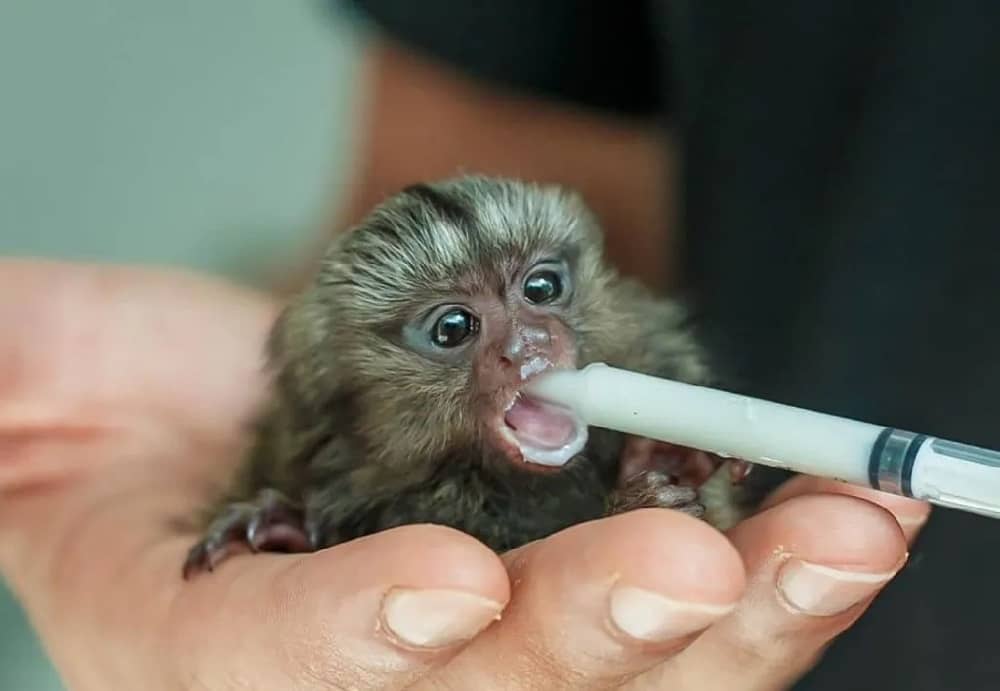
Finger monkeys also love to drink tree sap for its natural sugar and nutrients. Make sure their diet is varied to keep them healthy. Avoid feeding them processed or sugary foods, as these can harm their health. Always provide fresh water in their enclosure.
Foods to Avoid for Finger Monkeys
- Processed foods
- Sweets
- Caffeine
- Dairy products
- Salty Foods
- High-fat Foods
- Avocados
Finger Monkey Cage requirements
Finger monkeys, also known as pygmy marmosets, need a well-designed cage to thrive. The cage should be spacious enough for them to move around, as they are active climbers and jumpers. A minimum cage size of 5 feet wide, 5 feet long, and 6 feet tall is recommended, but larger is always better. The cage must include multiple perches, branches, and ropes to allow for climbing, swinging, and jumping, mimicking their natural habitat. Adding plants, leaves, and hiding spots provides enrichment and makes them feel secure.
The cage should be made of sturdy, non-toxic materials and have a secure lock to prevent escapes, as finger monkeys are intelligent and curious. it should also have proper ventilation and be placed in a warm, draft-free area to maintain a consistent temperature of around 75- 85°F (24-29°C). A humidity level of 60-80% is important to replicate their tropical environment. The cage should be cleaned regularly to prevent health issues, so the cage design should allow easy access for maintenance. Accessories like feeding stations, toys, and water bottles should be securely attached and checked regularly for safety.
Cleaning Schedule for The Finger Monkey Cage
Keeping a finger monkey’s cage clean is important for their health and happiness.
1.) Daily Cleaning: Remove uneaten food, replace the water, wipe down the surface, and clean up any waste.
2.) Weekly Cleaning: Take out all the toys, branches, and other items. Wash and disinfect them with a pet-safe cleaner. Clean the cage bars, floor, and corners thoroughly. And replace old bedding with fresh, clean material.
3.) Deep cleaning (monthly): If possible, disassemble the cage, wash all parts, check for damage or rust, and fix it if needed. Sanitize the entire cage and let it dry completely before reassembling and adding the toys and accessories.
Always use pet-safe cleaning products to avoid harmful chemicals. Regular cleaning keeps your finger monkey healthy and their living space fresh.
How to Handle Finger Monkey?
When handling a finger monkey, it’s important to be gentle and calm. Start by gaining their trust through slow movements and soft, soothing tones. Avoid sudden actions, as these small monkeys can get scared easily. Let them approach you first and offer treats to build a bond. When they feel comfortable, use your hands to gently scoop them up, supporting their body.
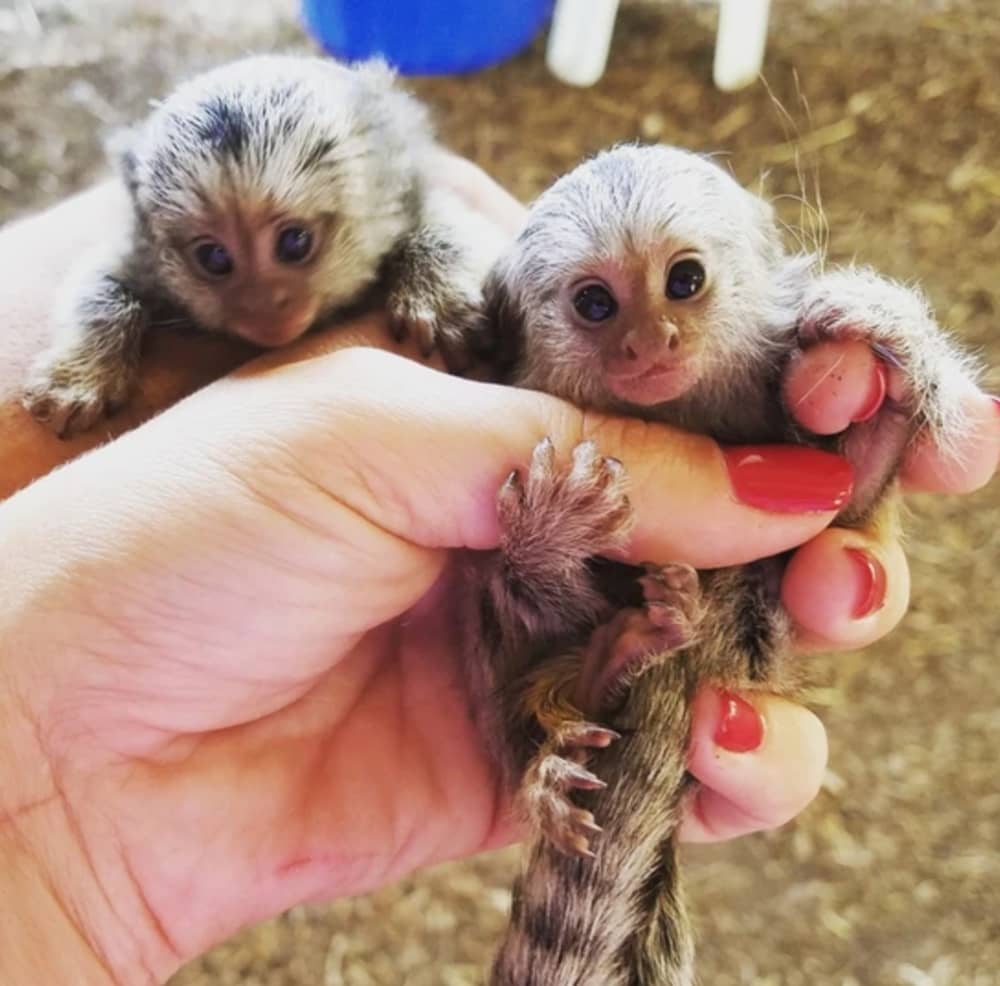
Never grab or restrain them forcefully, as this can cause stress or injury. Handling them daily in a gentle manner helps keep them socialized and comfortable around humans. Always supervise children when they are interacting with finger monkeys to ensure safety for both.
Exercise
Finger monkeys need regular exercise to stay healthy and active. These tiny primates are naturally energetic, so it’s essential to provide a space where they can climb, jump, and explore. Set up a cage with branches, ropes, and platforms, allowing them to move freely. Out-of-cage time in a safe, monkey-proofed area is also helpful. This exercise not only keeps them physically fit but also stimulates their minds, reducing boredom and preventing behavioral issues. Regular play sessions and toys that encourage movement can help finger monkeys stay happy and engaged.
Health Issues of Finger Monkeys:
Finger monkeys, like other small animals, can face several health issues if not properly cared for. Common health problems include respiratory infections, which can occur due to cold temperatures or drafts. They might also suffer from digestive issues if they eat the wrong foods or get too much sugar. Skin problems, like dryness or parasites, are also a concern, especially if their living environment is not clean.
Fingers monkeys can also experience stress-related illnesses, which may happen if they are left alone for too long or if their environment changes suddenly. Another issue is malnutrition, which can occur if they don’t get the right balance of fruits, insects, and other nutrients. To keep them healthy, it’s important to have regular check-ups with a vet who specializes in exotic animals and to maintain a clean and stable environment for them. Proper diet, hygiene, and attention help prevent these health issues.
Reproduction& Breeding of Finger Monkeys
Finger monkeys typically reach sexual maturity at around 12–18 months. Breeding pairs often form strong bonds and the female has a gestation period of about 140-150 days. She usually gives birth to twins, although single births and triplets are also possible. The newborns are tiny, weighing about 15 grams each.
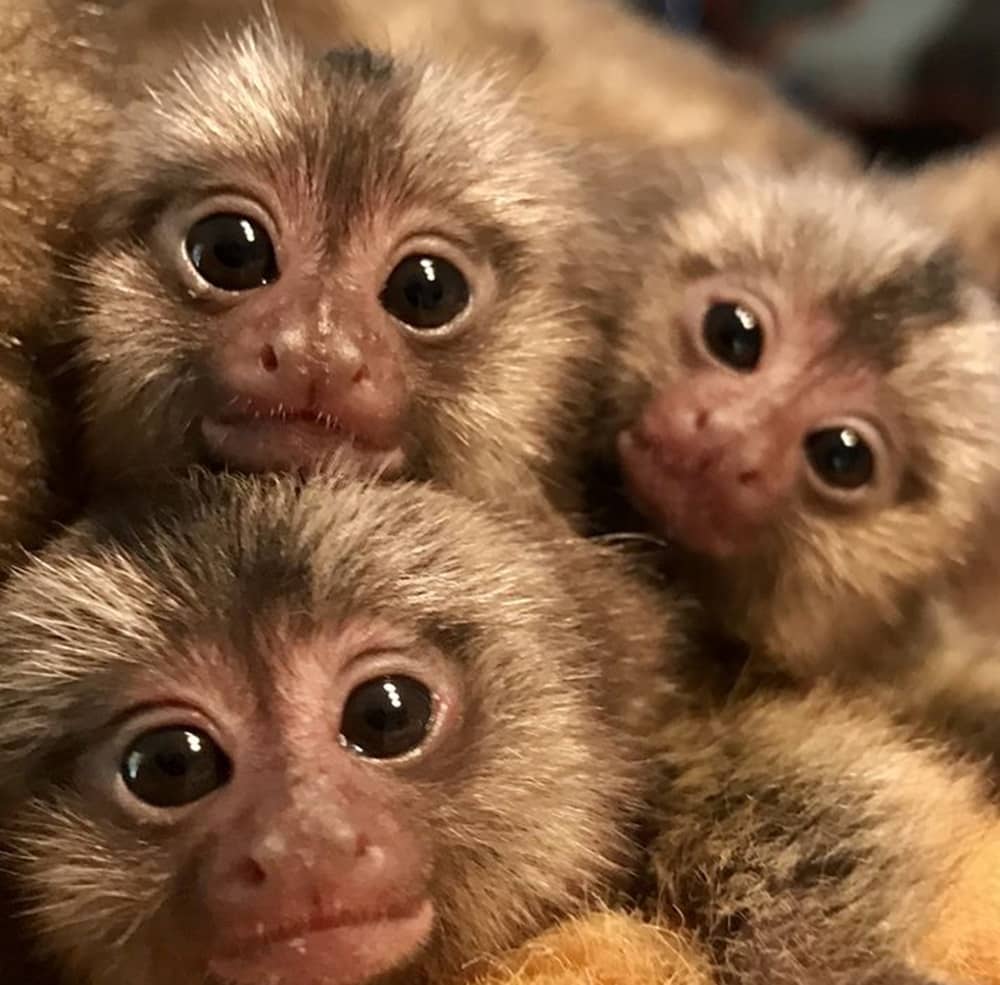
Both parents actively participate in caring for the young, with the male often carrying the babies on his back to give the mother rest. Breeding finger monkeys in captivity requires a stable environment, proper nutrition, and minimal stress. It’s important to consult with a veterinarian experienced with primates for proper care and monitoring throughout the breeding process.
Potty Training of Finger Monkey
Potty training a finger monkey can be challenging, but it is possible with patience and consistency. Start by observing when and where your finger monkey tends to go to the bathroom. Please set up a specific spot in their cage with a litter box or pads and place their waste there to help them understand the area is for pottying. When they use the designated spot, reward them with a treat and praise. Be consistent in your approach; over time, they may learn to associate that spot with bathroom habits. Keep in mind that, like many animals, accidents will happen, so patience is key.
Where to Buy
The finger monkeys can be purchased from an authentic online store or a reputed breeder. You can also check some adoption and rescue centers to get them.
Interesting Facts about Finger Monkeys
- Finger monkeys live high up in the trees of the rainforest in South America.
- They use their sharp fingernails like claws to help them climb trees.
- They eat a variety of foods, including butterflies, fruits, berries, and tree sap.
- Pygmy marmosets often form lifelong bonds, with one male and one female staying together as a pair.
- They groom each other’s fur, showing social behavior similar to other monkeys.

Frequently Asked Questions
Question 1: How to care for finger monkeys?
Answer: Finger monkeys need a spacious cage with branches for climbing and toys for stimulation. Provide a balanced diet including fruits, vegetables, insects, and specialized primate pellets. They also need a warm environment and regular veterinary care. Interaction and handling should be gentle to keep them social and happy.
Question 2: What is the lifespan of a finger monkey?
Answer: Finger monkeys, also known as pygmy marmosets, can live up to 12–15 years in captivity when given proper care. In the wild, their lifespan is shorter due to predators and environmental challenges.
Question 3: Can I keep a finger monkey as a pet?
Answer: Yes, finger monkeys can be kept as pets, but they require a lot of attention, specialized care, and a suitable habitat. Research the legal requirements and responsibilities before adopting one, as they can be high-maintenance animals.
Question 4: What kind of cage should a finger monkey have?
Answer: Marmoset monkeys need a large, secure cage with plenty of vertical space and branches for climbing. The cage should include enrichment items like toys and roses, and it must be placed in a warm, draft-free area.
Question 5: Do finger monkeys smell?
Answer: Yes, finger monkeys have scent glands that they use for marking their territory and communication. This can create a musky smell, especially if they are not regularly cleaned.
Question 6: Do finger monkeys require any vaccinations?
Answer: Yes, finger monkeys may require vaccinations similar to those given to other primates. Consult a veterinarian who specializes in exotic animals to know the necessary vaccines and schedule.
Question 7: Do finger monkeys show anger?
Answer: Finger monkeys show signs of aggression when they attain maturity. When angry, they may throw feces.
Question 8: Do finger monkeys bite?
Answer: Yes, finger monkeys can bite, especially if they are threatened or are not properly socialized. It’s important to handle them gently and give them space when they show signs of discomfort.
Question 9: Do finger monkeys throw their poop?
Answer: While it’s not common behavior for finger monkeys to throw poop, they can engage in such behavior if stressed or feeling threatened. Keeping their environment enriched and ensuring they feel safe can minimize such actions.
Question 10: Are capuchin monkeys and finger monkeys the same?
Answer: The capuchin monkeys and finger monkeys are not the same and differ in their looks, size, behavior, and habitats.
Conclusion
To take care of a finger monkey, you need to provide them with a safe and comfortable environment. Make sure their cage is spacious, with branches and toys for them to climb and explore, as they are very active and curious. Feed them a balanced diet, including fruits, vegetables, insects, and tree sap, to keep them healthy. Handle them gently and give them time to adjust to you, as finger monkeys can be shy or nervous at first. Regular veterinary check-ups are essential to monitor their health and prevent any potential issues.


